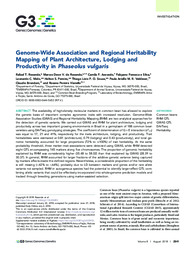Genome-wide association and regional heritability mapping of plant architecture, lodging and productivity in Phaseolus vulgaris.
Genome-wide association and regional heritability mapping of plant architecture, lodging and productivity in Phaseolus vulgaris.
Autoria: RESENDE, R. T.; RESENDE, M. D. V. de; AZEVEDO, C. F.; SILVA, F. F. e; MELO, L. C.; PEREIRA, H. S.; SOUZA, T. L. P. O. de; VALDISSER, P. A. M. R.; BRONDANI, C.; VIANELLO, R. P.
Resumo: The availability of high-density molecular markers in common bean has allowed to explore the genetic basis of important complex agronomic traits with increased resolution. Genome-Wide Association Studies (GWAS) and Regional Heritability Mapping (RHM) are two analytical approaches for the detection of genetic variants. We carried out GWAS and RHM for plant architecture, lodging and productivity across two important growing environments in Brazil in a germplasm of 188 common bean varieties using DArTseq genotyping strategies. The coefficient of determination of G · E interaction (c2 int) was equal to 17, 21 and 41%, respectively for the traits architecture, lodging, and productivity. Trait heritabilities were estimated at 0.81 (architecture), 0.79 (lodging) and 0.43 (productivity), and total genomic heritability accounted for large proportions (72% to 100%) of trait heritability. At the same probability threshold, three marker?trait associations were detected using GWAS, while RHM detected eight QTL encompassing 145 markers along five chromosomes. The proportion of genomic heritability explained by RHM was considerably higher (35.48 to 58.02) than that explained by GWAS (28.39 to 30.37). In general, RHM accounted for larger fractions of the additive genetic variance being captured by markers effects inside the defined regions. Nevertheless, a considerable proportion of the heritability is still missing (42% to 64%), probably due to LD between markers and genes and/or rare allele variants not sampled. RHM in autogamous species had the potential to identify larger-effect QTL combining allelic variants that could be effectively incorporated into whole-genome prediction models and tracked through breeding generations using marker-assisted selection.
Ano de publicação: 2018
Tipo de publicação: Artigo de periódico
Unidade: Embrapa Florestas
Observações
1 - Por padrão são exibidas publicações dos últimos 20 anos. Para encontrar publicações mais antigas, configure o filtro ano de publicação, colocando o ano a partir do qual você deseja encontrar publicações. O filtro está na coluna da esquerda na busca acima.
2 - Para ler algumas publicações da Embrapa (apenas as que estão em formato ePub), é necessário ter, no celular ou computador, um desses softwares gratuitos. Sistemas Android: Google Play Livros; IOS: iBooks; Windows e Linux: software Calibre.
Acesse outras publicações
Acesse a Base de Dados da Pesquisa Agropecuária (BDPA) para consultar o acervo completo das bibliotecas da Embrapa.

